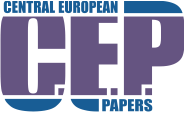Central European Papers 2013, 1(1):17-26 | DOI: 10.25142/cep.2013.003
The Debate of the Romanian Concordat from the Perspective of Hungarian Catholics in the Twenties of the 20th Century
- Művészettudományi és Szabadbölcsészeti Intézet, Bölcsészettudományi Kar, Károli Gáspár Református Egyetem, Institute of Arts Studies and General Humanities, Faculty of Humanities, Károli Gáspár University of the Reformed Church in Hungary, Reviczky Street 4, 1088 Budapest, Hungary, sarnyai.csaba.mate@gmail.com
Due to the territorial redistributions following WW1, Transylvania became a part of Romania. Most of its population were Hungarian-speaking Catholics. For the Romanian state, the conclusive resolution of their issues was the agreement with the Holy See in Rome. On the one hand, the Catholics obliged to the standpoint of Rome, on the other hand, due to the international situation, Romania could not afford to avoid an official agreement with the Pope in the case of Hungarian Catholics, in order to prevent accusations of anti-religiousness. The official diplomatic communication between Bucharest and the Vatican began in 1919 and concordat negotiations began in 1920.
It was signed on 10 May 1927 and was only ratified by the Romanian parliament on 13 June 1929. During this long process, the Romanian legislation had several important events that affected the situation of the churches and thus that of the minority society. These are the first to be discussed in the paper.
Afterwards, we briefly address the principles and practice of the contemporary concordat policy of the Holy See. Each involved party (Roman Catholic Hungarian minority, Orthodox Romanians, the Romanian government and Eastern Catholic Romanians) reacted to leaked negotiation details differently. This is presented in the next section. In the last part of the paper, we examine the main points, aftermath and evaluation of the final and accepted concordat, from the viewpoint of the Catholic Hungarians.
Keywords: Religious freedom, ethnic minorities, concordats and minorities
Published: March 1, 2013 Show citation
References
- Endre BARABÁS, A magyar iskolaügy helyzete Romániában 1918-1940. I., in: Kisebbségi Körlevél 6, 1943, 3, 272-275.
- Béla POMOGÁTS, Változó Erdély, Budapest 1994.
- Zsombor SZÁSZ, Az Erdélyi Római Katholikus Státus I., in: Magyar Szemle 7, 1933, 17.
- Lajos NAGY, A kisebbségek alkotmányjogi helyzete Nagyromániában, Erdélyi Tudományos Intézet, Kolozsvár 1944.
- Sándor KERESZTURY, A bukaresti patriárkátus és az erdélyi magyar kisebbségek, in: Magyar Kisebbség 5, 1926, 1, 22-25, 23-24.
- Elemér JAKABFFY, A konkordátum és a nemzetkisebbségek, in: Magyar Kisebbség 10, 1931, 2, 49-52.
- Elemér GYÁRFÁS, A német birodalommal kötött konkordátum, in: Magyar Kisebbség 12, 1933, 19-20, 566-580.
- Zsombor SZÁSZ, Az Erdélyi Római Katolikus Státus II., in: Magyar Szemle 17, 1933, 3, 290-296.
- Gábor PÁL, Konkordátum és a katolikus magyarság, In: Magyar Kisebbség 7, 1928, 18, 678-693.
- Benedek JANCSÓ, A katolikus egyház helyzetet Romániában, 59-64.
- Elemér GYÁRFÁS, A Szentszék és az erdélyi katolikusok, in: Magyar Kisebbség 7, 1928, 19, 717-726.
- Elemér GYÁRFÁS, A konkordátum és az erdélyi katolikusok, In: Magyar Kisebbség 8, 1929, 12, 445-470.
- Márton METZGER, A konkordátum, in: Magyar Kisebbség 3, 1924, 22.
- Péter SAS, Az erdélyi római katolikus egyház 1900-1948. Budapest 2008.
- Árpád BITAY (transl.): Törvény a konkordátum ratifikálásáról in: Magyar Kisebbség 8, 1929, 12, 473-480.
- János JÓSIKA, A konkordátum ratifikálása, in: Magyar Kisebbség 8, 1929, 12, 471-472.
- János SCHEFFLER, Az "Erdélyi Katolikus Státus" küzdelmes húsz éve in: Magyar Szemle 15, 1941, 5, 299-310.
- Sándor BÍRÓ, Kisebbségben és többségben. Románok és magyarok (1867-1940), in: Európai Protestáns Magyar Szabadegyetem, Bern 1989.
- Csaba Máté SARNYAI, Az erdélyi katolikusság "kiáltó szava" a pápához (1921). A román konkordátum-javaslaés az erdélyi hívek reagálása, in: Székelyföld 13, 2009, 9, 89-99.
This is an open access article distributed under the terms of the Creative Commons Attribution 4.0 International License (CC BY 4.0), which permits use, distribution, and reproduction in any medium, provided the original publication is properly cited. No use, distribution or reproduction is permitted which does not comply with these terms.



